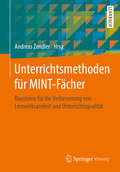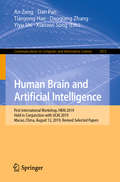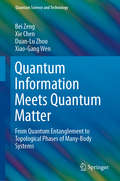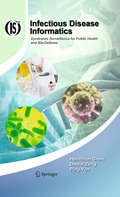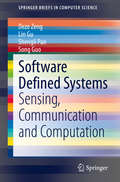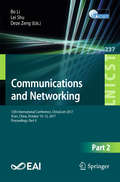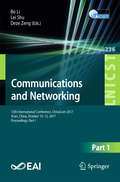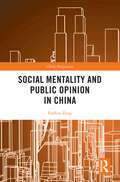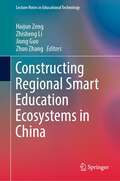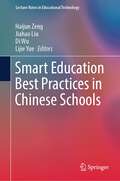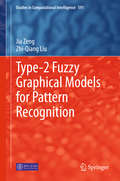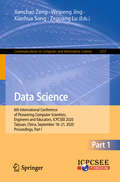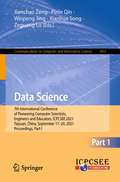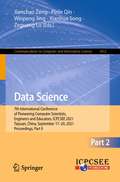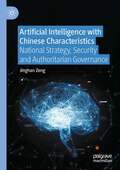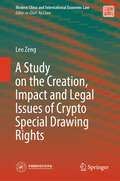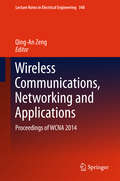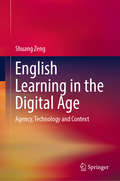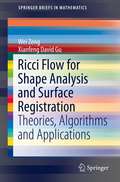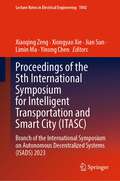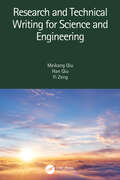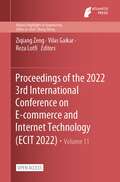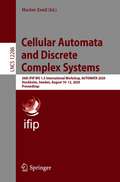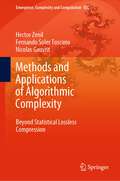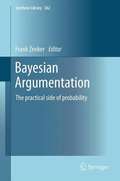- Table View
- List View
Unterrichtsmethoden für MINT-Fächer
by Andreas ZendlerMathematik, Informatik, Naturwissenschaften (Biologie, Chemie, Physik) und Technik - seit Jahren findet in der breiten Öffentlichkeit eine angeregte Diskussion über diese sogenannten MINT-Fächer statt. Denn das in den MINT-Fächern vermittelte Wissen ist die unverzichtbare Grundlage für die Ausbildung der in Deutschland dringend benötigten Fachkräfte. Darum fordern Politik und Wirtschaft eine stärkere Gewichtung der Fächer, aber auch eine Verbesserung der Unterrichtsqualität. Dieses Buch stellt 20 verschiedene, wissenschaftlich fundierte Methoden für den MINT-Unterricht vor und erläutert die Rolle der digitalen Medien als fächerübergreifendes Element. Die interdisziplinäre Betrachtungsweise bietet Lehrern einen umfassenden Überblick über die verschiedenen Möglichkeiten und Ansätze für den eigenen Unterricht. Für jede der vorgestellten Methoden geben die Autoren wissenschaftliche fundierte Einschätzungen zu ihrer Lerneffektivität und erleichtern so Lehrkräften die Auswahl der geeignetsten Methoden für den eigenen Unterricht. Detaillierte Unterrichtsmodelle helfen bei der Umsetzung in der Praxis. Damit erhalten Lehrer und Lehramtsstudenten einen umfassenden Einblick in die effektivsten Unterrichtsmodelle für ein prozess- und ergebnisorientiertes Lernen in den MINT-Fächern. Dieses Buch lässt sich ideal fächerübergreifend einsetzen und dient dazu, die Lerneffektivität speziell im MINT-Unterricht bei Schülerinnen und Schülern zu verbessern.
Human Brain and Artificial Intelligence: First International Workshop, HBAI 2019, Held in Conjunction with IJCAI 2019, Macao, China, August 12, 2019, Revised Selected Papers (Communications in Computer and Information Science #1072)
by An Zeng Dan Pan Tianyong Hao Daoqiang Zhang Yiyu Shi Xiaowei SongThis book constitutes the refereed proceedings of the workshop held in conjunction with the 28th International Conference on Artificial Intelligence, IJCAI 2019, held in Macao, China, in August 2019: the First International Workshop on Human Brain and Artificial Intelligence, HBAI 2019. The 24 full papers presented were carefully reviewed and selected from 62 submissions. The papers are organized according to the following topical headings: computational brain science and its applications; brain-inspired artificial intelligence and its applications.
Quantum Information Meets Quantum Matter: From Quantum Entanglement to Topological Phases of Many-Body Systems (Quantum Science and Technology)
by Bei Zeng Xie Chen Duan-Lu Zhou Xiao-Gang WenThis book approaches condensed matter physics from the perspective of quantum information science, focusing on systems with strong interaction and unconventional order for which the usual condensed matter methods like the Landau paradigm or the free fermion framework break down. Concepts and tools in quantum information science such as entanglement, quantum circuits, and the tensor network representation prove to be highly useful in studying such systems. The goal of this book is to introduce these techniques and show how they lead to a new systematic way of characterizing and classifying quantum phases in condensed matter systems. The first part of the book introduces some basic concepts in quantum information theory which are then used to study the central topic explained in Part II: local Hamiltonians and their ground states. Part III focuses on one of the major new phenomena in strongly interacting systems, the topological order, and shows how it can essentially be defined and characterized in terms of entanglement. Part IV shows that the key entanglement structure of topological states can be captured using the tensor network representation, which provides a powerful tool in the classification of quantum phases. Finally, Part V discusses the exciting prospect at the intersection of quantum information and condensed matter physics – the unification of information and matter. Intended for graduate students and researchers in condensed matter physics, quantum information science and related fields, the book is self-contained and no prior knowledge of these topics is assumed.
Infectious Disease Informatics: Syndromic Surveillance for Public Health and Bio-Defense (Integrated Series in Information Systems #21)
by Daniel Zeng Hsinchun Chen Ping YanComputer-based infectious disease surveillance systems are capable of real-time or near real-time detection of serious illnesses and potential bioterrorism agent exposures and represent a major step forward in disease surveillance. Infectious Disease Informatics: Syndromic Surveillance for Public Health and Bio-Defense is an in-depth monograph that analyzes and evaluates the outbreak modeling and detection capabilities of existing surveillance systems under a unified framework, and presents the first book-length coverage of the subject from an informatics-driven perspective. Individual chapters consider the state of the art, including the facilitation of data collection, sharing and transmission; a focus on various outbreak detection methods; data visualization and information dissemination issues; and system assessment and other policy issues. Eight chapters then report on several real-world case studies, summarizing and comparing eight syndromic surveillance systems, including those that have been adopted by many public health agencies (e.g., RODS and BioSense). The book concludes with a discussion of critical issues and challenges, with a look to future directions. This book is an excellent source of current information for researchers in public health and IT. Government public health officials and private-sector practitioners in both public health and IT will find the most up-to-date information available, and students from a variety of disciplines, including public health, biostatistics, information systems, computer science, and public administration and policy will get a comprehensive look at the concepts, techniques, and practices of syndromic surveillance.
Software Defined Systems: Sensing, Communication and Computation (SpringerBriefs in Computer Science)
by Deze Zeng Lin Gu Shengli Pan Song GuoThis book introduces the software defined system concept, architecture, and its enabling technologies such as software defined sensor networks (SDSN), software defined radio, cloud/fog radio access networks (C/F-RAN), software defined networking (SDN), network function virtualization (NFV), software defined storage, virtualization and docker. The authors also discuss the resource allocation and task scheduling in software defined system, mainly focusing on sensing, communication, networking and computation. Related case studies on SDSN, C/F-RAN, SDN, NFV are included in this book, and the authors discuss how these technologies cooperate with each other to enable cross resource management and task scheduling in software defined system. Novel resource allocation and task scheduling algorithms are introduced and evaluated. This book targets researchers, computer scientists and engineers who are interested in the information system softwarization technologies, resource allocation and optimization algorithm design, performance evaluation and analysis, next-generation communication and networking technologies, edge computing, cloud computing and IoT. Advanced level students studying these topics will benefit from this book as well.
Communications and Networking: 12th International Conference, Chinacom 2017 Xi'an, China, October 10-12, 2017, Proceedings, Part I (Lecture Notes of the Institute for Computer Sciences, Social Informatics and Telecommunications Engineering #236)
by Deze Zeng Bo Li Lei ShuThe two-volume set LNICST 236-237 constitutes the post-conference proceedings of the 12th EAI International Conference on Communications and Networking, ChinaCom 2017, held in Xi’an, China, in September 2017. The total of 112 contributions presented in these volumes are carefully reviewed and selected from 178 submissions. The papers are organized in topical sections on wireless communications and networking, satellite and space communications and networking, big data network track, multimedia communications and smart networking, signal processing and communications, network and information security, advances and trends of V2X networks.
Communications and Networking: 12th International Conference, Chinacom 2017, Xi'an, China, October 10-12, 2017, Proceedings, Part Ii (Lecture Notes of the Institute for Computer Sciences, Social Informatics and Telecommunications Engineering #237)
by Deze Zeng Bo Li Lei ShuThe two-volume set LNICST 236-237 constitutes the post-conference proceedings of the 12th EAI International Conference on Communications and Networking, ChinaCom 2017, held in Xi’an, China, in September 2017. The total of 112 contributions presented in these volumes are carefully reviewed and selected from 178 submissions. Aside from the technical paper sessions the book is organized in topical sections on wireless communications and networking, satellite and space communications and networking, big data network track, multimedia communications and smart networking, signal processing and communications, network and information security, advances and trends of V2X networks.
Social Mentality and Public Opinion in China (China Perspectives)
by Fanbin ZengThis book explores the relationship between social mentality, public opinion, media, and other factors through mixed methods in China, especially since the 21st century.The book deploys qualitative and quantitative research and adopts a multi-disciplinary perspective and diversified research methods. The studies are built on and contribute to the burgeoning literature seeking to anatomize the relationship between social mentality, media, and public opinion from the point of view of sociology and communication. It also aims to explore how media can be used to appease public opinion. As the first systematic study of the interconnection between social mentality and public opinion, this book provides empirical support and a theoretical framework for both areas. It will thus be a great read for students and scholars of communication, sociology, and social psychology, especially for those with a focus on China and new media.
Constructing Regional Smart Education Ecosystems in China (Lecture Notes in Educational Technology)
by Haijun Zeng Zhisheng Li Jiong Guo Zhuo ZhangThis book enriches the understanding of regional smart education in China and promotes sharing of smart education case studies in China and abroad. It presents 46 case studies selected from a total of 644 case studies collected nationwide in China. These selected case studies focus on regional construction, research findings, and solutions. The case studies on regional construction mainly focus on the sustainable development mechanism of regional smart education. The research findings case studies showcase research results produced by research teams and individuals, which involve theories, models, technologies, practical investigations, or international comparisons related to smart education. Lastly, the solution case studies are technical solutions provided by enterprises for the development of smart education, which include application scenarios, methods, and effects in regions or schools around smart educational equipment, platforms, networks, tools, resources, or integrated solutions.
Smart Education Best Practices in Chinese Schools (Lecture Notes in Educational Technology)
by Haijun Zeng Jiahao Liu Di Wu Lijie YueThis book presents 28 practical case studies in detail and 49 case studies in brief. The collection of these case studies focuses on one or more aspects of exploration and practice on the following topics: smart campus and smart classroom, resource construction and sharing, new teaching mode, comprehensive quality evaluation of students, teacher professional development, application of teaching platform and tool, innovative application of online learning space, collaborative education, and school management and services. The selection and evaluation criteria of the case studies on school practice mainly include concept and implementation, effectiveness and characteristics, innovation and demonstration, and expression and structure. This book helps readers gain a rich understanding of the diverse innovative implementation of smart education in Chinese schools and inspires smart education development in schools in other countries.
Type-2 Fuzzy Graphical Models for Pattern Recognition
by Jia Zeng Zhi-Qiang LiuThis book discusses how to combine type-2 fuzzy sets and graphical models to solve a range of real-world pattern recognition problems such as speech recognition, handwritten Chinese character recognition, topic modeling as well as human action recognition. It covers these recent developments while also providing a comprehensive introduction to the fields of type-2 fuzzy sets and graphical models. Though primarily intended for graduate students, researchers and practitioners in fuzzy logic and pattern recognition, the book can also serve as a valuable reference work for researchers without any previous knowledge of these fields. Dr. Jia Zeng is a Professor at the School of Computer Science and Technology, Soochow University, China. Dr. Zhi-Qiang Liu is a Professor at the School of Creative Media, City University of Hong Kong, China.
Data Science: 6th International Conference of Pioneering Computer Scientists, Engineers and Educators, ICPCSEE 2020, Taiyuan, China, September 18-21, 2020, Proceedings, Part I (Communications in Computer and Information Science #1257)
by Jianchao Zeng Weipeng Jing Xianhua Song Zeguang LuThis two volume set (CCIS 1257 and 1258) constitutes the refereed proceedings of the 6th International Conference of Pioneering Computer Scientists, Engineers and Educators, ICPCSEE 2020 held in Taiyuan, China, in September 2020. The 98 papers presented in these two volumes were carefully reviewed and selected from 392 submissions. The papers are organized in topical sections: database, machine learning, network, graphic images, system, natural language processing, security, algorithm, application, and education.The chapter “Highly Parallel SPARQL Engine for RDF” is available open access under a Creative Commons Attribution 4.0 International License via link.springer.com.
Data Science: 7th International Conference of Pioneering Computer Scientists, Engineers and Educators, ICPCSEE 2021, Taiyuan, China, September 17–20, 2021, Proceedings, Part I (Communications in Computer and Information Science #1451)
by Jianchao Zeng Pinle Qin Weipeng Jing Xianhua Song Zeguang LuThis two volume set (CCIS 1451 and 1452) constitutes the refereed proceedings of the 7th International Conference of Pioneering Computer Scientists, Engineers and Educators, ICPCSEE 2021 held in Taiyuan, China, in September 2021.The 81 papers presented in these two volumes were carefully reviewed and selected from 256 submissions. The papers are organized in topical sections on big data management and applications; social media and recommendation systems; infrastructure for data science; basic theory and techniques for data science; machine learning for data science; multimedia data management and analysis; social media and recommendation systems; data security and privacy; applications of data science; education research, methods and materials for data science and engineering; research demo.
Data Science: 7th International Conference of Pioneering Computer Scientists, Engineers and Educators, ICPCSEE 2021, Taiyuan, China, September 17–20, 2021, Proceedings, Part II (Communications in Computer and Information Science #1452)
by Jianchao Zeng Pinle Qin Weipeng Jing Xianhua Song Zeguang LuThis two volume set (CCIS 1451 and 1452) constitutes the refereed proceedings of the 7th International Conference of Pioneering Computer Scientists, Engineers and Educators, ICPCSEE 2021 held in Taiyuan, China, in September 2021.The 81 papers presented in these two volumes were carefully reviewed and selected from 256 submissions. The papers are organized in topical sections on big data management and applications; social media and recommendation systems; infrastructure for data science; basic theory and techniques for data science; machine learning for data science; multimedia data management and analysis; social media and recommendation systems; data security and privacy; applications of data science; education research, methods and materials for data science and engineering; research demo.
Artificial Intelligence with Chinese Characteristics: National Strategy, Security and Authoritarian Governance
by Jinghan Zeng“This book provides the first book-lengthy study focusing on Artificial Intelligence (AI) with Chinese characteristics, in line with China’s open ambition of becoming an AI superpower by 2030. China’s unique domestic politics has developed distinct characteristics for its AI approach. By analysing national strategy, security and governance aspects of AI in China, this book argues that China’s AI approach is sophisticated and multifaceted, and it has brought about both considerable benefits and challenges to China. First, many characterize China’s AI approach as a nationally concerted top-down geopolitical strategy to advance Beijing’s unified objective. This book argues that this view is mistaken. It shows that China’s AI politics is largely shaped by economically rather than geopolitically motivated domestic stakeholders. In addition, China’s national AI plan is an upgrade of existing local AI initiatives to the national level, reflecting a bottom-up development. Thus, China’s AI strategy is more of a political manifesto rather than a concrete policy plan. The second part of the book discusses how the Chinese central government has been securitizing AI in order to mobilize local states, market actors, intellectuals and the general public. This security discourse is built on China’s historical anxieties about technology, regime security needs and the growing tension caused by great power competition. Despite its help in convincing domestic actors, however, this securitization trend may undermine key AI objectives. The third part of the book studies the Chinese governance approach to the use of AI. It argues that China’s bold AI practices are part of its broad and incoherent adaptation strategy to governance by digital means. AI is part of a digital technology package that the Chinese authoritarian regime has actively employed not only to improve public services but also to strengthen its authoritarian governance. While China’s AI progress benefits from its unique political and social environment, its ambitious AI plan contains considerable risks. China’s approach is gambling on its success in (a) delivering a booming AI economy, (b) ensuring a smooth social transformation to the age of AI, and (c) proving ideological superiority of its authoritarian and communist values. This book suggests that a more accurate understanding of AI with Chinese characteristics is essential in order to inform the debate regarding what lessons can be learnt from China’s AI approach and how to respond to China’s rise as the AI leader if not superpower.”
A Study on the Creation, Impact and Legal Issues of Crypto Special Drawing Rights (Modern China and International Economic Law)
by Leo ZengThis book analyzes the concept, theory, rules, and impact of the reform of the international monetary system and Crypto-SDRs and provides a feasibility analysis of the combination of blockchain technology and SDRs. It explores and summarizes the possibility of solving problems such as the inherent defects of the current international monetary system and creatively suggests that the birth of Crypto-SDR will have a positive impact on countries and industries and fields around the world, especially in anti-money laundering, cross-border asset recovery, international payments, banking, insurance, financial auditing, Fintech regulation, etc.
Wireless Communications, Networking and Applications
by Qing-An ZengThis book is based on a series of conferences on Wireless Communications, Networking and Applications that have been held on December 27-28, 2014 in Shenzhen, China. The meetings themselves were a response to technological developments in the areas of wireless communications, networking and applications and facilitate researchers, engineers and students to share the latest research results and the advanced research methods of the field. The broad variety of disciplines involved in this research and the differences in approaching the basic problems are probably typical of a developing field of interdisciplinary research. However, some main areas of research and development in the emerging areas of wireless communication technology can now be identified. The contributions to this book are mainly selected from the papers of the conference on wireless communications, networking and applications and reflect the main areas of interest: Section 1 - Emerging Topics in Wireless and Mobile Computing and Communications; Section 2 - Internet of Things and Long Term Evolution Engineering; Section 3 - Resource Allocation and Interference Management; Section 4 - Communication Architecture, Algorithms, Modeling and Evaluation; Section 5 - Security, Privacy, and Trust; and Section 6 - Routing, Position Management and Network Topologies.
English Learning in the Digital Age: Agency, Technology and Context
by Shuang ZengMoving beyond the ‘Web 2.0’ and ‘digital native’ rhetoric, this book addresses the complex experiences of learners of English as a foreign language (EFL) in a world embedded with interactive and participatory technologies. Adopting a sociocultural perspective, it investigates EFL learners’ behaviours concerning digital technology, and guides exploration into their contextually mediated choices and learning practices in the ‘2.0’ era.The argument is developed on the basis of the findings of a mixed sequential study that focused on 1485 Chinese undergraduates’ use and non-use of online tools and applications outside the English classroom. Particular attention is paid to the role of context and agency when understanding their learning choices and behaviours in the context of digital technology. In particular, the book acknowledges the explanatory power of agency in the minority instances of ‘good practices’ among these EFL learners. At the same time it demonstrates that for most learners, use of the current web is limited and mostly non-interactive. The barriers to ‘2.0’ transfer are largely contextual and the so-called ‘communicative opportunities’ and ‘participatory culture’ in particular did not fit into the learners’ sociocultural context of (language) learning.Overall, the compelling argument proposes that the technology-facilitated changes in EFL practices are a ‘bottom up’ process that is taking place in day-to-day situations and constrained by the learning context within which the learner is situated. Based on these arguments, the book provides a framework that challenges the existing beliefs about (language) learning with online technology, and that contributes to our understanding of how context mediates EFL learners’ behaviours surrounding digital technologies. It is a valuable resource for teachers, researchers and policy makers, providing them with insights into using digital technology to stimulate ‘good learning practices’ outside the classroom.
Ricci Flow for Shape Analysis and Surface Registration
by Wei Zeng Xianfeng David GuRicci Flow for Shape Analysis and Surface Registration introduces the beautiful and profound Ricci flow theory in a discrete setting. By using basic tools in linear algebra and multivariate calculus, readers can deduce all the major theorems in surface Ricci flow by themselves. The authors adapt the Ricci flow theory to practical computational algorithms, apply Ricci flow for shape analysis and surface registration, and demonstrate the power of Ricci flow in many applications in medical imaging, computer graphics, computer vision and wireless sensor network. Due to minimal pre-requisites, this book is accessible to engineers and medical experts, including educators, researchers, students and industry engineers who have an interest in solving real problems related to shape analysis and surface registration.
Proceedings of the 5th International Symposium for Intelligent Transportation and Smart City: Branch of the International Symposium on Autonomous Decentralized Systems (ISADS) 2023 (Lecture Notes in Electrical Engineering #1042)
by Xiaoqing Zeng Xiongyao Xie Jian Sun Limin Ma Yinong ChenThis book presents research advances in intelligent transportation and smart city in detail, mainly focusing on green traffic and urban utility tunnels, presented at the 5th International Symposium for Intelligent Transportation and Smart City (ITASC 2022) held at Tongji University, Shanghai, on May 20-21, 2022. It is also branch of the International Symposium on Autonomous Decentralized Systems (ISADS) 2023. Due to rapid development in the domain of intelligent transportation and smart city, many popular topics are included, such as the 2BMW system (Bus, Bike, Metro and Walking), transportation safety and environment protection, urban utility design and application, the application of BIM in the city design. This book collects papers with high quality, including some authoritative scholars and most experienced engineers’ latest achievements, which will provide guidance to those both in universities and entrepreneurs in the field of transportation and urban planning. The first conference in the ITASC series was held in 2013 as a workshop of the International Symposium on Autonomous Decentralized System (ISADS) in Mexico City. The second to fourth were held in May 2015, 2017 and 2019, respectively, in Tongji University, Shanghai.
Research and Technical Writing for Science and Engineering
by Yi Zeng Meikang Qiu Han QiuEngineering and science research can be difficult for beginners because scientific research is fraught with constraints and disciplines. Research and Technical Writing for Science and Engineering breakdowns the entire process of conducting engineering and scientific research. This book covers those fascinating guidelines and topics on conducting research, as well as how to better interact with your advisor. Key Features: advice on conducting a literature review, conducting experiments, and writing a good paper summarizing your findings. provides a tutorial on how to increase the impact of research and how to manage research resources. By reflecting on the cases discussed in this book, readers will be able to identify specific situations or dilemmas in their own lives, as the authors provide comprehensive suggestions based on their own experiences.
Proceedings of the 2022 3rd International Conference on E-commerce and Internet Technology (Atlantis Highlights in Engineering #11)
by Ziqiang Zeng Vilas Gaikar Reza LotfiThis is an open access book.Due to recent pandemic, the 2022 3rd International Conference on E-commerce and Internet Technology (ECIT 2022) which was planned to be held in Zhangjiajie, China, was held virtually online during March 4- 6, 2022. The decision to hold the virtual conference was made in compliance with many restrictions and regulations that were imposed by countries around the globe. Such restrictions were made to minimize the risk of people contracting or spreading the COVID-19 through physical contact. There were 90 individuals who attended this on-line conference, represented many countries including Singapore, USA, India and China. ECIT is to bring together innovative academics and industrial experts in the field of E-Commerce and Internet Technology to a common forum. The primary goal of the conference is to promote research and developmental activities in E-Commerce and Internet Technology. Another goal is to promote scientific information interchange between researchers, developers, engineers, students, and practitioners working all around the world. The conference will be held every year to make it an ideal platform for people to share views and experiences in E-Commerce and Internet Technology and related areas. During the conference, the conference model was divided into three sessions, including oral presentations, keynote speeches, and online Q&A discussion. The proceedings are a compilation of the accepted papers and represent an interesting outcome of the conference. Topics include but are not limited to the following areas: E-commerce and digital business, Information economy and enterprise management, Digital economy and artificial intelligence technology and Application and other related topic. All the papers have been through rigorous review and process to meet the requirements of international publication standard. We would like to acknowledge all of those who supported ECIT 2022. The help and contribution of each individual and institution was instrumental in the success of the conference.
Cellular Automata and Discrete Complex Systems: 26th IFIP WG 1.5 International Workshop, AUTOMATA 2020, Stockholm, Sweden, August 10–12, 2020, Proceedings (Lecture Notes in Computer Science #12286)
by Hector ZenilThis volume constitutes the refereed post-conference proceedings of the 26th IFIP WG 1.5 International Workshop on Cellular Automata and Discrete Complex Systems, AUTOMATA 2020, held in Stockholm, Sweden, in August 2020. The workshop was held virtually.The 11 full papers presented in this book were carefully reviewed and selected from a total of 21 submissions. The topics of the conference include dynamical, topological, ergodic and algebraic aspects of CA and DCS, algorithmic and complexity issues, emergent properties, formal languages, symbolic dynamics, tilings, models of parallelism and distributed systems, timing schemes, synchronous versus asynchronous models, phenomenological descriptions, scientific modeling, and practical applications.
Methods and Applications of Algorithmic Complexity: Beyond Statistical Lossless Compression (Emergence, Complexity and Computation #44)
by Hector Zenil Fernando Soler Toscano Nicolas GauvritThis book explores a different pragmatic approach to algorithmic complexity rooted or motivated by the theoretical foundations of algorithmic probability and explores the relaxation of necessary and sufficient conditions in the pursuit of numerical applicability, with some of these approaches entailing greater risks than others in exchange for greater relevance and applicability. Some established and also novel techniques in the field of applications of algorithmic (Kolmogorov) complexity currently coexist for the first time, ranging from the dominant ones based upon popular statistical lossless compression algorithms (such as LZW) to newer approaches that advance, complement, and also pose their own limitations. Evidence suggesting that these different methods complement each other for different regimes is presented, and despite their many challenges, some of these methods are better grounded in or motivated by the principles of algorithmic information. The authors propose that the field can make greater contributions to science, causation, scientific discovery, networks, and cognition, to mention a few among many fields, instead of remaining either as a technical curiosity of mathematical interest only or as a statistical tool when collapsed into an application of popular lossless compression algorithms. This book goes, thus, beyond popular statistical lossless compression and introduces a different methodological approach to dealing with algorithmic complexity. For example, graph theory and network science are classic subjects in mathematics widely investigated in the twentieth century, transforming research in many fields of science from economy to medicine. However, it has become increasingly clear that the challenge of analyzing these networks cannot be addressed by tools relying solely on statistical methods. Therefore, model-driven approaches are needed. Recent advances in network science suggest that algorithmic information theory could play an increasingly important role in breaking those limits imposed by traditional statistical analysis (entropy or statistical compression) in modeling evolving complex networks or interacting networks. Further progress on this front calls for new techniques for an improved mechanistic understanding of complex systems, thereby calling out for increased interaction between systems science, network theory, and algorithmic information theory, to which this book contributes.
Bayesian Argumentation: The practical side of probability (Synthese Library #362)
by Frank ZenkerRelevant to, and drawing from, a range of disciplines, the chapters in this collection show the diversity, and applicability, of research in Bayesian argumentation. Together, they form a challenge to philosophers versed in both the use and criticism of Bayesian models who have largely overlooked their potential in argumentation. Selected from contributions to a multidisciplinary workshop on the topic held in Sweden in 2010, the authors count linguists and social psychologists among their number, in addition to philosophers. They analyze material that includes real-life court cases, experimental research results, and the insights gained from computer models. The volume provides, for the first time, a formal measure of subjective argument strength and argument force, robust enough to allow advocates of opposing sides of an argument to agree on the relative strengths of their supporting reasoning. With papers from leading figures such as Michael Oaksford and Ulrike Hahn, the book comprises recent research conducted at the frontiers of Bayesian argumentation and provides a multitude of examples in which these formal tools can be applied to informal argument. It signals new and impending developments in philosophy, which has seen Bayesian models deployed in formal epistemology and philosophy of science, but has yet to explore the full potential of Bayesian models as a framework in argumentation. In doing so, this revealing anthology looks destined to become a standard teaching text in years to come.
